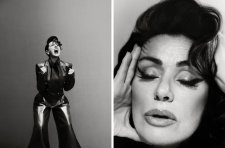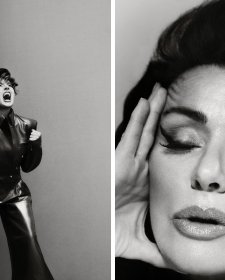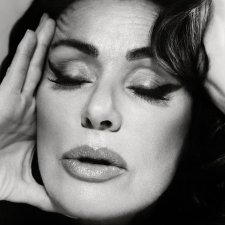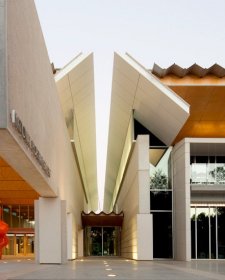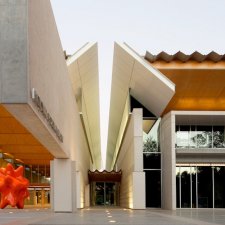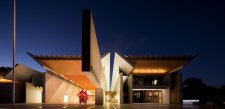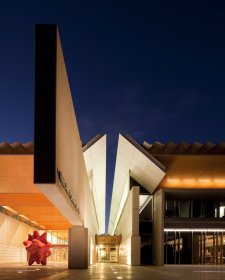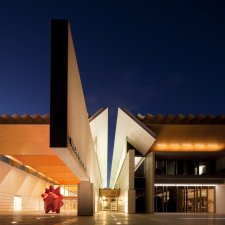Good morning and welcome to the National Portrait Gallery. My name is Sarah Oakes and I'm the Director of External Relations here at the Gallery. Now we are at absolute capacity this morning, the tickets to this session booked out in a matter of hours. So I know you are as excited as we are to launch this very special work, the portrait of Tina Arena by Georges Antoni. Tina Arena celebrates 50 years in the Australian music industry next year and our exquisite new portrait of Tina commemorates this moment and today with all of you present it officially becomes a part of the national collection, a forever tribute to a national icon. Now for those joining us online and I know there are many of you, I need to tell you that it is the most glorious day on Ngunnawal and Ngambri country. The sun is shining, the air is crisp and the wattles are in bloom. So I'd like to start as we always do by acknowledging the Ngunnawal and Ngambri people as the traditional custodians of the beautiful land on which the gallery stands. It's a privilege to live and work on Ngunnawal and Ngambri country and I'd like to acknowledge their continuing culture and the contribution they make to the life in this city and region. I'd also like to acknowledge and welcome any First Nations people here in the audience and attending online. Now a couple of quick housekeeping matters. For the first, for those in the room, phones on silent, and for those online, mics on mute. Now unfortunately, we're not going to take questions today, but do not fear because we are in the hands of our most eloquent and experienced moderator, please give a warm welcome to the director of the National Portrait Gallery and your host this morning, Bree Pickering. Please give a warm welcome to the artist we are here to celebrate Georges Antoni. And double trouble, he is joined by our guest of honour, Miss Tina Arena, ladies and gentlemen. Thank you everybody and now over to your host and our director, Bree.
Good morning everyone. Thank you so much for joining us. You are in for a very special treat today. Tina Arena is an Australian icon. She has built an extraordinary and enduring career that began when she was eight years old as a contestant and then a regular performer on Young Talent Time. And that continues and is still going strong to this day almost 50 years later. Her second album, which I know you all own, is Don't Ask, and it was the highest selling album in Australia in 1995. That year she picked up five ARIA awards and became the first woman in ARIA history. to win album of the year. In 2015, she was inducted into the ARIA Hall of Fame, and a year later, recognized as a member of the Order of Australia, for significant service to the Australian music industry. Significant service doesn't really cut it, though, is it? It's a little more than significant. Globally, she has achieved two World Music Awards and a Brit, and in 2011, became the first Australian awarded a knighthood of the French National Order of Merit for her contribution to her contribution French culture. She has sold 10 million albums worldwide to date and she's not slowing down. Well, I mean, we can get to that, Tina.
Georges Antoni is a renowned Australian fashion photographer who has worked continuously for magazines including Vogue, Harper's Bazaar, Marie Claire, ID, V Magazine, NL, and has shot for fashion houses such as Versace and Hugo Boss. and he's built a formidable list of high-profile subjects, from Monica Bellucci to Rihanna and to Australian icons to numerous to name. He's been on TV, and his work has appeared on an Australian 50-cent piece, which I did not know, Georges, and an Australian stamp. We have Georges' stunning portrait of the late Carla Zampatti in the collection, but this is his very first commission for the National Portrait Gallery.
And the gallery's commissions are the cornerstone of the National portrait collection. These are the works that the gallery creates and that speak to Australian culture and history through the story of an extraordinary individual and by the hand of an artist. You two have a very special connection and in many ways your lives and careers have intersected even though you met for the very first time on this shoot. So I'm going to encourage us to just let this conversation go wherever it needs to go. Oh no. Oh, oh, yes, but, but There is some territory I'd like us to cover. I'd like us to talk about this portrait, what it is and what it means to you. We have to talk about family and friends. And I'd like us to touch on some career-defining moments, both in the past but now and into the future if we can. I'm going to do a little bit of gentle guiding, but I'm guessing I'll also be just so enthralled that I might forget what my job is and just be listening in. So you've got to help me. Georges, I'm going to start with you. I'm going to start with you. Your career has been extraordinary. As a fashion photographer, you've hit pretty much every mark that there is to hit. But I'm guessing this shoot was no ordinary shoot. Can you tell us how you felt going into it and a little bit about what the day was like? Absolutely.
First of all, I'd like to thank everyone for coming and listening to us. It's a really a big pleasure and an honour for you guys all to be here, including everyone at home watching. I was so nervous. So I'm not the one that typically gets nervous on a photo shoot, even with big celebrities, to be honest, because I don't know, celebrities not something really that rubs off on me very much. It's not something that's incredibly important to me. But when it came to Tina, it was very different for me. And it was different for me because I think, Tina, I met for the first time on the shoot this year. year, technically. But I actually met Tina when I was five years old. Because I used to boogie down with Tina without her realising and my three older sisters, pretty much every young talent time, as well as throughout every album. And so I feel like Tina and I went through a number of bad fashion stages together without Tina actually knowing about it. So I suppose what I'm trying to say is I don't typically get nervous when I take celebrity portraits, but in this particular case I did because Tina was a very important part of a formative time in my life and a formative time in my sister's lives. And I could see how much they looked up to you. And because they looked up to you, I looked up to you, and then so on and so forth. So really, when I first got commissioned, I didn't believe it. I thought my agent. was joking. And then once I came to terms that it was actually real, there was an extreme level of nerves. So out of 10, probably a 12. And then soon after that, it became pure excitement. And having had to do some research on, some more deep research on Tina to make sure that I could, I could really make the most of this portrait. began to really fall in love with not just the artist that I'd grown up with, but I fell in love with the persona that you'd created in the media. And I thought that it wouldn't get any better than that, that once I met you, it couldn't really go any higher than that. But the thing, ladies and gentlemen, that I can assure you, having had this six months with Tina, to get to this point, is as amazing as you think she is, you have absolutely no idea until you really get to know her. So she has been the greatest, one of the greatest privileges in my life.
And I can answer the high points of my career. This is most certainly it. Oh, sure. Thank you. It's going to be an emotional ride, people. So come with us on this. Tina. I mean, you've been photographed. You wouldn't even be able to count how many times. No, no, I wouldn't. What was your favourite thing about the shoot day? I think, hi everyone, thank you for coming. There are a few things, clearly, being asked to take a portrait for the National Portraits Gallery, which represents a part of in Australian culture was an extraordinary honour. It's something I think I had quietly hoped for for a few years and sort of wondered. I thought, well, I've kind of been around for so long. I'm wondering why I'm not on those walls. You know, is something, have I pissed somebody off? Have I said something that someone just goes, oh, she's a pain in the ass, whatever. I guess I didn't believe it either in the beginning. I thought, oh my God, this is really serious. I was nervous. And then as soon as they said to me, Georges Antoni is going to photograph it, I automatically just went, holy shit. And then I went, okay, I'm not going to research this man. I don't need to. His work speaks for itself. I think I looked at a couple of covers and I went, yeah, yeah, yeah. No, that's it. He's going to be fine. And then I thought, am I going to be up to par for Georges to be able to photograph me? Am I going to be able to deliver for Georges so then that Georges can take an exquisite portrait? Am I a good enough subject manner? Then when we got into the whole thing, I realized That in what it is that we do in art and in music, if we do not have the right spirits around us and people with the right intentions, it just doesn't work. Or what you see on a wall is just a manifestation of something that is okay that we must do this. But the result of that work is what you see on a wall is just a manifestation of something that is okay that we must do this, but the result of what it is because it was a bunch of people that were chosen specifically to come together to capture me in a moment that would be able to stand the test of time. And I really believe that that is something that can only really happen when you have the right group of people that come together, that have the intention, the collective intention, the collective intention, of creating something. So it's not about our egos. I have an ego that is probably healthy. I don't think it's unhealthy. I still ask myself a lot of questions. I still go, am I going to be right? Am I going to be good enough for this exquisite photographer to be able to be happy with what I see on those walls?
This portrait is what it is, it is what it is, ladies and gentlemen, because of the extraordinary collective of individuals that enable these walls to be what it is that they are, to tell the stories that they tell. Because you guys are exquisite humans. That's the first thing. Then you have a great photographer, which is, it either works or it doesn't. It doesn't. And then you have the village that make you look great. Because I can't do this on my own. I'm shit. I can't do my hair. I don't wear any makeup. You know, I'm always at home. I'm very natural. I can't wear makeup every day. It's not a part of who I am. So I was unbelievably fortunate to have all of these people come together to create that body of work. It's more than the subject. It's more. So, voila, that's it. That's it. Georges, maybe you could take us a little bit through the creative process. I mean, one of the things at the National Portrait Gallery is we work with artists all the time. And in the visual art world, there's this real sense of like the solo genius. And what was so magical, I was present for this shoot, and it's like a life highlight. I don't know how I'm going to top it. But this sense of collaboration that was sitting there. And then Georges, the way you've talked about how an image is constructed. I mean, you know who you are, you know your talent, it's very clear, but you work in a way that draws all of these things together that I think really are the magic that Tina's talking about. So, yeah, can you take us through it?
Thanks. First of all, thank you for all the compliments. I don't know if my mum has been paying you girls, but she's definitely not paid you enough. I think, do you know, I think a wonderful, to kind of backtrack to a more philosophical perspective to discuss what Tina had so kindly and eloquently said. I think there's two critical components to making a beautiful, honest portrait that hopefully will stand the test of time. And I think the first, there needs to be a generosity of spirit from the sitter. And Tina, you have that in abundance. And I think everyone realizes that within the first two sentences of what you've said today, that your generosity of spirit is always there. So it's much easier for me when people don't have that generosity of spirit for me to blame somebody else if the portrait's bad. But you've got it, so I could only blame myself if it went wrong. But you need another thing. And that other thing is, I mean, the Latin term for it is consensus at Eden. But what that actually means is pretty much a meeting of the minds. So I believe that a great portrait, especially a great portrait that revolves around fashion and beauty, which we focused on for this one, is really about, as a photographer, As a photographer, a lot of it, and creative directors who are involved on the shoot. It's about conducting an orchestra. And it's about allowing, really, the most important thing is getting the right people into the room. If you get the right people into the room and you give them enough scope and enough energy and enough authority to be able to influence what we do, then you typically will get something that is unique and hopefully stands on its own. And the greatest gift. for people like us is that the work doesn't look referenced, that it looks original. And I feel as though when you have everybody come in and provide their own language to that situation, you automatically get something that doesn't look referential. If I can just elaborate on what Georges is actually saying, there's something I learnt in art that I think is really fundamental. And that is, is that I don't believe in micromanaging artists and telling them what to do. I give them some sort of a brief and say what I'd really like to achieve with this is such and such. and I just, if I walk into, I'm not going to sit and tell Georges how to take his photo or micromanage him and go, I don't like my left side, I don't like my right side. you can only shoot me from here. I'm like, well, all of, you know, that, you're walking into a scenario with instant limitations. I can't do that. So I believe in letting the fashion, the choice of the clothes, somebody take that initiative, and then it is up to me to say, you know what, I really love that. I feel really comfortable in that, but I actually don't feel as comfortable. feel as comfortable in this? Would it be possible if we could try this and that?
So it's a question of constant communication, respect for one another, respect for their ability, because that's why you have chosen them to be a part of this objective. So that's the way I feel. It's like someone's saying to me, oh, trying to teach me how to sing. It's like, well, thanks. I mean, I'll take a note. I've always taken constructive criticism. because I believe in it. I really do. But at the end of the day, I believe in professionals doing what it is that they do. And then if I'm not comfortable, there is a way in communicating that in a loving way that doesn't make somebody feel inferior, it doesn't make them feel insecure, all of those things are very important. So it's a constant, dance of communication and being really free in your honesty, understanding that if you're not honest, you're doing the entire project and injustice. So that's the way I felt. If I don't feel comfortable in something, I'll say to Mikey, my stylist, Mikey, I don't feel comfortable in that. I feel like mutton dressed as lamb. Because that's not what it is. I'm not a fashion, I'm not a model. I'm a woman that loves fashion. fashion. I appreciate it. I grew up with a mother who was a seamstress and a really good one. You know, and I just appreciate all of that, you know. But I don't for one second think that I'm a mannequin. Like I'm just like, Georges needs to capture who I am. Not the bloody clothes or anything else. It's me. It's the spirit. And that's what happened through that trust. It's just about trusting. And I do walk into whatever scenario, I believe that I have to have trust and hope. And if I manifest that, it's usually what happens. It's usually comes about. I think, sorry, just to also quickly add to that, the beauty of the relationship was because we hadn't met, we'd spoken on the phone for 15 minutes beforehand, and so many people have asked, I've asked me since the portrait has been up, how many times did you guys sit to get these photos? And I said, well, actually, we sat, we got pretty much both of those photos in the first hour, and we didn't have to sit again to take any further portraits. And I think a big reason for that is that we had an immediate connection that is that is is stems from a similarity in backgrounds. Definitely a similarity in education, that's for sure. Yep. And also, I think similar paths in trying to create something that is truly unique. And I think when you both have that kind of path that you're trying to take, you can follow each other's journey intimately with through your own, through your own as well. And I feel as though that really got us to where we needed to go, and that's that's why hopefully if you guys like the portrait, that would be the result of it. If you don't, it was Tina's fault. We might come to the portrait, but I think, Georges, we might digress back to family. Because one of the things on that day that was so incredible was lunch, and sitting around the table together, and immediately, I mean, I was just sort of a way, or to be honest, watching you two talk, but you talked about family, you talked about food, you talked about food, you talked about your heritage is, and I wonder if you could take us through, like, the synergies between the way you grew up and the differences maybe and just what it means to you, and how it's influenced the kind of art that you both make.
Okay. Well, I come from a very, very, very, very big Italian family, and music, art and food was very, very much a big part of who we are, right? And even my friends, when we all come together, you know, we'll either cook, we'll have food, I'll have a sponge in my hand, I'll clean up, I'll feed them, I'll take away their plates before they're finished, because it's got to be tidy. When we realize that, you know, I think our families, we've been lucky to have a gift, which comes from somewhere else, but I think your families help you either harness that or they don't. And I think that we come from really loving families, our parents came here, mine came here with nothing, just a trunk full of wedding presence and engagement presence and Linan and, you know, and things like that. They had nothing. And so they built a life here and they integrated pretty successfully. And it was always about the respect of family, because without those foundations, I don't think that you're really able to build on character unless you're, I don't know, I don't know, my family are the reason why I think I've still continued. So Georges and I realized that our families are really similar in the way in which they see things, our parents, our moms and dads, who love us through good, bad and indifferent. and who are also ready to reprimand us, too, when something's not right. My mother will still say, ah, what are you doing? You haven't coloured your hair. You look like shit. Like, what are you doing? And I'm like, Mom, can't. She goes, no, no, no, no, go get your hair coloured. Just go do it. So my mother's never really minced her words, like, right? You know my mom, man. So my mom's just like, straight down the line. And, you know, sometimes I go, well, I think I would have preferred that rather than a mum may be saying to me, oh, darling, you're amazing, you know, everything you do is spectacular. And it's not.
So it's interesting, Tina. My mum is an exact combination of both of those things. I know. She's sitting here in the second row. And so if everything, I'll walk in and I'll be exhausted, I put on 15 kilos, my hair's, I look like the sixth member of the Jackson Five. I walk in home and mum goes, Habib, you look like the most beautiful thing I've ever seen. You are so handsome. There's no one as handsome as you in the world. You're lucky. But I don't get that. No, but then, no, but then in the same breath, Tina, in the same breath, Tina, in the same breath, I'll say, I'll give my son, I don't know, a piece of bread with toast. And she's like, That's so bad for him. You need to give him olives. That's true. So I get both sides of that. I think the one thing that the love of any family from any ethnicity gives you, especially in our game, is a very real sense of perspective. Because I feel as though in the arts, the thing that probably people, people don't consciously recognize when you're an artist is that you really need to be getting things wrong in order to get them right. I agree. I spent most of my life getting shit wrong. Yeah. Seriously. Yeah. Or at least you need to be risking everything to get it right. And that means being risking to getting everything wrong. So that requires a particular strength of character that I think is very much reinforced by if you want the safety net under the trapeze, which is the love of your family. So if I ever slip off the trapeze, I always know that I'm going to be caught. And what that does, it allows me to try a more risky adventure on the next time I'm up there. And I think without that support, I would not have been able to make any of the progress that I made. I know. I know that I would never have survived without my family and my inner sanctum, my close friends.
There's something I've realized very recently, it kind of dawned on me, and I'd never thought about it before. It actually really hit home with me in the recent months of the sacrifices that I've made. And with those sacrifices comes an enormous amount of loneliness. And I've experienced. profound loneliness in these last five years that I actually never thought I would. And whilst it's a really difficult thing to live through, I also am grateful for the gift of understanding what that is, what loneliness actually means. And that's what it requires to be a great artist. this enormous sacrifice. You put yourself out in a position of being constantly ridiculed or celebrated. And you get lonely. And people don't understand that because the media creates these storylines and narratives that we lead extraordinary lives. And we can lead beautiful lives if we've got the right balance in our lives, right? But also being somebody who's in the public, in the public eye is also exposed to an extraordinary amount of criticism and particularly in a world today where you get people that will sit behind a computer and will write whatever they feel they want to because they're not feeling good about themselves and so they will project it on whoever's in front of them and just vomit that onto them. And it's really, that's a difficult, that's a difficult, that's a difficult, it's a difficult thing to navigate through, and to rise above that requires great strength, which I'm learning to do every day.
But, yeah, I don't know, I've derived a bit, but it is sacrifice, it's phenomenal sacrifice, and also the risk of going, I could really get this wrong, and if I do, I do, and it just is what it is, or I might get it right. But you have to make it. a lot of mistakes before you get to a place where you're really comfortable and go, I'm comfortable now. And I'm at a point in my life now where I don't feel I need to impress anybody other than just be good to myself and not hard on myself. Because as artists, we have like these extrasensory antennas that are around us. So we absorb so much. We absorb so much. good energy, we absorb very negative energy. And it requires phenomenal work to be able to work through that, to not allow the negativity to bring you down, and to be able to harness that positivity without it pushing you over the edge where your ego becomes so disproportionate that you can no longer see the forest from the trees. So for me, in order to keep my mind, in order to keep my balance is that I keep my life really simple. I'm in charge of my own life. I've made my mistakes. I've made some good choices. And I try and surround myself with really good people who love me and people who have the courage to tell me when something is wrong and not to sit there and yes me to death. Because the first person that does that to me, I don't want them in my life, because they're not being honest to me. That's it. It's pretty simple.
I think you'd both agree that great art requires openness and vulnerability, but you have to have quite a thick skin to stay in that space for as long as you have, as long as you have, Tina. Now, if you haven't seen the portrait, I think that when you do, openness, vulnerability, a sort of deep dive into Tina's soul is what you'll see. And as Georges said, these photographs maybe happened in the first hour, but you took, I mean, I don't know, hundreds, right? How many photos did you take, Georges? Let's not discuss how bad I am at getting focused, but... These I hate to think, honestly. I think it was. like maybe, actually Johnny's here, he would know, 4,000 maybe, I think. Johnny, how many photos? Five thousand photos. Three and a half thousand of them were out of focus because I'm so blind. You couldn't take out of focus if you tried, smart ass. Seriously. So this portrait is a dip-tick, so two photographs making a single artwork. So four and a half thousand photos, how did you get there? So it might have been me being a little bit excited about the opportunity of shooting to the arena that got us there. All I kept hearing was a ch-ch-ch-ch-ch-ch-ch-ch-ch-ch-ch-ch. Oh my God. I think that may have contributed to that shot count. But I'll tell you the interesting thing was when I was, I got together with Isobel to do the edit, excuse me, you would think that you typically would get 10 usable photos out of a portrait session, if you're lucky, and then you begin to look at the storytelling within those photos, and then you begin to see if they depict what we've discussed and whether it is a, shines a light on the complexity of Tina's history in her 50 years and so on. But we had 680 usable photos that were all brilliant. And so... Plenty of picks to throw darts at, kids. Bullseye. So it literally became a war of attrition in trying to keep our eyes, you know, open to the subtleties for the next, you know, five hours of trying to choose the right types of vote. And even then we had to do it in stages.
You should have seen me when I received the first bunch of photos to approve. They arrived in the computer and went, I can't do that. I can't, no, I freaked out. I was like, Michael, I said, Michael, I can't do that. I can't go through these things. It's like, what do you mean? I said, I can't. I'm not sure I'm best placed for it. I mean, I know, I know when I see great photos because I've got an eye, right? I can appreciate beauty and not only beauty, and not only beauty. even something that's not beautiful, but that talks to me. I can appreciate that. But when I have to be constructive about me, I'm like, man, I'm just not sure I'm best place for that. But you know, that's... Like really, it's tough. That's an amazing gift to us, that you do have that level of separation between, because many people in your situation would be very concerned about how people perceive them them in the way they like to be perceived. Yeah, but that's too controlling, Georges. Then what you do there is, again, you are controlling a piece of art. You can't control art. It's something out of nothing. When we got into that room, did we sit there and go, oh, we're going to get this portrait, this is exactly what we're going to do, da-da-da, and it's going to work. You don't know how it's going to work. You don't have a clue. You just don't have a clue. Well, I certainly don't. And that's why I... I learned to trust because I feel that that's the only way to create that beauty is by trusting somebody else, giving them the impetus and the responsibility and going, no, you're good at this. This is what you do. I trust that you will do the right thing. Then if I see the photo and I go, you know what, Georges, I'm not sure about that because of ABC. of ABC. But I need to trust Georges. Georges is the master in that. It's not me. I'm not the master in that. I'm just the subject. That's all. That you are far more than the subject because... I'm a ball-breaker. Well, that's true. Yeah, but you laugh. But I've got three older sisters and I'm used to it. Exactly. Exactly. You know exactly.
And they come from a matriarchal family with a very strong wife. That's why we get along, because I'm one of three girls. You grew up with three sisters, so we know the landscape very well. I do think that you, you know, you hit the nail on the head where you said that we, the level of trust is important because I feel like you can tell a portrait story through first person, which was you would be you selecting. you selecting and how you would perceive yourself would impact that.
I do think it's a very generous gift to both, you know, Isobel, the Portrait of Gallery and Bree and I that you allowed us that gift of interpreting you in third person. And I feel as though there is a gift in that in looking at those pictures because I think both those pictures have enough ambiguity to allow the viewer to determine what they think you're thinking. That is what. What I love about these photos is the fact that whoever looks at them, they will have a feeling. It'll evoke an emotion for them. So the viewer has enough freedom to be able to feel and look at it the way they want to look at it and that the ambiguity is really what's quite extraordinary in those photos. I also know that when I'm looking at a photo and I look at the subject, I know when it's contrived, I can feel the contrived and the control when I'm looking at the photo. It kind of slaps me in the face. I don't feel that with this. I feel like every time you look at it, you pick something new up. That's amazing. That's amazing. That's like. Thank you. We've done our jobs. Good night, ladies and gentlemen. Well, that's how I feel. I'm getting the one more primarily.
We could definitely sit here all day. I'd lost track of time. Tina, I think it would be lovely for everyone to hear you walk us through what it was like seeing that portrait for the first time. Oh. It was how was it that two, three weeks ago. three weeks ago, the girl said, Tina, we'd like you to come up, you and Michael to come up, so we're going to reveal the portrait. And I'm like, oh my God, okay, get ready for this. So I psychologically had to prepare myself. I thought, okay, I was nervous. I was nervous because I loved the session the session, but it still didn't mean that I knew what it was going to be like. So I arrived here in the morning. We came here, the girls, Sarah and Bree and Isobel, we all went downstairs into the archives, and they kept me back in a room, they held me in a room till they got everything ready and they set up all the crew and the camera to capture my first reaction. So I'm really. I'm sitting there, I'm very nervous, I'm very nervous, I'm pacing, I'm sitting there, I'm sweating. And I'm thinking, I'm either this is either going to be amazing, or I'm going to disappear up my own backside, one of the two, and they'll have spent all this money, and what a waste. So anyway, I got ready, the door opened, they walked me through, and there was these two big portraits. portraits hanging off a mesh grill where there were all these other paintings stocked behind. My first thing was I gasped literally, and I cried because I had waited a lifetime to be captured like that. I waited 50 years to be captured like that. That's a long time to wait. particularly when you see other colleagues, Australian colleagues, grace walls, grace magazine covers, grace all of this, and predominantly Anglo-Saxon women. And I turned around and I said, where are we European women who have made a contribution to this landscape? Where are we? Why aren't we there? And then I thought, And then I thought, oh well, it doesn't matter. I'll bypass the cover of Vogue or whatever. Doesn't matter. I still love them. Guess what? My fat head's on the wall of the National Portrait Gallery, ladies and gentlemen. So, try and beat that. And when you walk in, my fat head is the first head. is the first head you see. So I guess everything else sort of faded into significance, you know? It's just like, yeah, whatever. So it doesn't matter about gracing that. But my point was it wasn't so much about me.
But it's about our community. Our community that deserve to be on the front cover of those magazines, even if we're not blonde and blue-eyed, and we don't fit the traditional aesthetic. aesthetic. This country is made up of so many beautiful and varying aesthetics, and that's what I feel is worth celebrating every colour, every creed. That's the beauty of any nation. And I hope that this portrait is the beginning of a movement where we as Australians will start to truly acknowledge what the Europeans have contributed to our cultural landscape on so many levels. So if it does that, Bree, I'm happy. I'm sure Georges will agree with me. I mean, although every beauty or everyone wants to be photographed by him now, understandably so, but I'm proud that we're representing our European roots on the wall, because that's where we deserve to. to be. That's just what I feel. And I say that with the greatest of humility, I really do. We deserve it. So there we are. I'll tell you where I was at the time that Tina was looking at the young. I was about waist deep in freezing cold water in a pool taking photos of handbags. and I got a phone call from the guy saying, Georges, Tina's about to look at the photo. Can you have a look? I'm like, yeah, I'd love to speak to. And... And... Handbags are very important things to take photographs. Oh, tell me about it. And so I... I got out of the pool and I said to everyone, look, I'm so sorry I've got to go to the toilet. And 45 minutes later, I come back. And they're like, ooh. I'm like, sorry, guys. That cold water. And, you know, I'm so glad. It's such obviously an incredible privilege that you had that that reaction, but geez, I was nervous. I sobbed so hard. I was just, it was, you know, and gone to the trouble of having making makeup done and stuff. I was like, why'd you bother? Seriously, it's just, it wasn't worth it. By the way, what handbags were you photographing? Mimco, I'll get you with her.
Oh, okay, okay. All right. Good Australian mark. Good. All right. Thank you so much, both for this incredible portrait, but also for your generosity that you've shown along this entire journey. And thank you for being here with us today. Could we all please please put our hands together for Georges and Tina. Thank you so much. Thank you to Georges. Thank you to Bree and thank you to all of you for coming along today. It's really appreciated. Enjoy all of those beautiful portraits in the gallery. We invite you to have a look. Go for it. Not only mine, there's plenty more that are fascinating in there. Thank you for coming, ladies and gentlemen. Thank you. Thank you, everybody, for joining us today. For those who are watching online, the big reveal should have just happened. You should be able to see the incredible portrait on your screens. But I encourage you to come and visit and see it in person because it is best appreciated. Its scale and its presence when you're standing right in front of it. Also, everybody, for noting just to the left before the portrait is a beautiful video that takes you behind the scenes on the day of the shoot. the day of the shoot, they'll help kind of visualise, like bring to life the conversation that we've just all had the privilege of listening to. So I encourage you now to go into the gallery and see the work. We're going to quickly tidy these chairs up for you and put them away. And just one final round of applause for our special guest, Bree Pickering, Georges Antoni and Tina Arena. Thank you.
